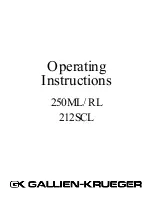
6
Mute to Tune
–
When this switch is engaged it mutes both the stage sound
and the D.I. send. Only the tuner output stays hot. The Mute is on or muted
when the LED is on.
Semi-Parametric Equalizer
–
Allows you to dial in a specific frequency to
enhance or cut. This feature is especially useful for upright and acoustic bass
guitars that have a resonant frequency. Because we’ve included a bypass
switch, you can also use it to create a second tone that is available
instantaneously. (You’re welcome.) The frequency is adjustable from 40Hz
to 10KHz. The level can be ad/- 15 dB. The control is FLAT when
the level control is at 12:00 position (straight up).
Three Band Tone Controls –
Divides the audio spectrum into three bands:
Bass, Mid, and Treble. The Bass and Treble controls are shelving type
filters. The Mid control is a band pass type filter. These controls give you a
broad general control of the tone shaping.
D.I. Selector
– Allows the user to choose to send the D.I. either pre-EQ or
post-EQ.
D.I. Level
– Controls the level being sent from the XLR balanced output
jack. We suggest setting the control at approximately 12 o’clock initially. If
the signal to the board is too hot, it’s better to engage the Input Pad on your
channel of the board than to turn it down here, if at all possible. In general,
it’s better (in terms of signal-to-noise ratio and dynamic presentation) to
send as hot a signal as possible to the board. However, you can adjust the
signal level, if necessary, so make sure your soundperson or recording
engineer is aware of this capability.
Master Volume
– Controls the main stage sound level and the Head Phone
outputs.
Headphone Jack
– Accepts a standard ¼ inch stereo or mono headphone
plug. It can also be used as a Master Output send to slave another amplifier.
DC Indicator
– When lit, shows that the low voltage power supplies are
operating.




































